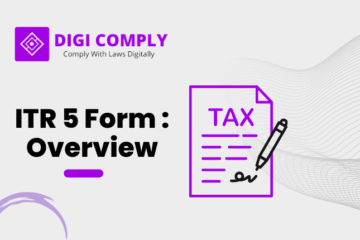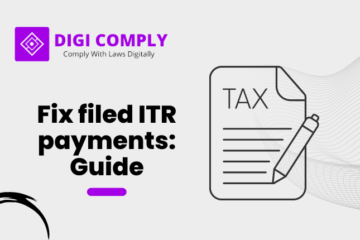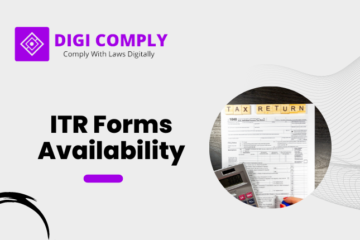The Department has recently released new Income Tax Return (ITR) forms for the Assessment Year 2024-2025. In this article, we aim to highlight the key changes in each ITR form to assist you in preparing the necessary documents during the filing of your ITR.
ITR-1:
- The updated ITR-1 form now includes a new section requiring the disclosure of amounts received from retirement benefit accounts, such as pension funds and annuities.
- Taxpayers are now required to disclose any arrears or additional amounts received under Section 89A in the ITR-1 form.
- Filing of returns using ITR-1 is no longer allowed solely based on depositing more than Rs. 1 crore in the current account.
- The ITR-1 form now references Section 153C for returns filed in response to a notice, ensuring clarity on the applicable legal provisions for taxpayers and aiding tax authorities in processing and evaluating such returns.
ITR-2:
- Like ITR-1, ITR-2 also includes a new section for disclosing amounts received from retirement benefit accounts, such as pension funds and annuities.
- Taxpayers using ITR-2 need to disclose any arrears or additional amounts received under Section 89A.
- A new Schedule VDA has been introduced to report profits from Virtual Digital Assets (VDA). If the VDA income is treated as capital gains, taxpayers must provide quarterly details under the Capital Gains Schedule.
- FII/FPIs are required to disclose their SEBI registration number in the ITR-2 form to enhance transparency.
- ITR-2 now requires the disclosure of the Donation Reference Number (ARN) for claiming deductions under Section 80G.
- There are significant changes in ITR-2 related to the sunset date for Section 80-IB deduction, specifically concerning the deduction available to industrial undertakings in Jammu & Kashmir or Ladakh.
- Revised ITR-2 forms now include provisions for reporting the transfer of Tax Collected at Source (TCS) credit to another person, ensuring proper documentation and tracking of TCS credits transferred between taxpayers.
ITR-3:
- ITR-3 also includes a new section for disclosing amounts received from retirement benefit accounts, such as pension funds and annuities.
- Taxpayers using ITR-3 need to disclose any arrears or additional amounts received under Section 89A.
- Similar to ITR-2, ITR-3 introduces Schedule VDA to report profits from Virtual Digital Assets (VDA) and requires quarterly details under the Capital Gains Schedule if VDA income is treated as capital gains.
- The ITR-3 form features a “Trading Account” section for reporting turnover and income from intraday trading, necessitating detailed reporting of intraday trading activities.
- FII/FPIs are required to disclose their SEBI registration number in the ITR-3 form.
- There is a change in balance sheet reporting, with the ITR-3 form now requiring the disclosure of Section 40A(2)(b) details under advances in the source of fund section.
- ITR-3 now includes provisions for reporting the transfer of Tax Collected at Source (TCS) credit to another person.
ITR-4:
- ITR-4 introduces the same new section for disclosing amounts received from retirement benefit accounts, such as pension funds and annuities.
- Taxpayers using ITR-4 need to disclose any arrears or additional amounts received under Section 89A.
- Schedule VDA is introduced in ITR-4 to report profits from Virtual Digital Assets (VDA), with the requirement to provide quarterly details under the Capital Gains Schedule if VDA income is treated as capital gains.
- The ITR-4 form features a “Trading Account” section for reporting turnover and income from intraday trading, necessitating detailed reporting of intraday trading activities.
- ITR-4 now requires the disclosure of the Donation Reference Number (ARN) for claiming deductions under Section 80G.
- Significant changes are introduced in ITR-4 related to the sunset date for Section 80-IB deduction, specifically concerning the deduction available to industrial undertakings in Jammu & Kashmir or Ladakh.
- Revised ITR-4 forms now include provisions for reporting the transfer of Tax Collected at Source (TCS) credit to another person.
ITR-5:
- ITR-5 introduces Schedule VDA to report profits from Virtual Digital Assets (VDA), requiring quarterly details under the Capital Gains Schedule if VDA income is treated as capital gains.
- The ITR-5 form features a “Trading Account” section for reporting turnover and income from intraday trading, necessitating detailed reporting of intraday trading activities.
- FII/FPIs are required to disclose their SEBI registration number in the ITR-5 form.
- ITR-5 now requires the disclosure of the Donation Reference Number (ARN) for claiming deductions under Section 80G.
- Significant changes are introduced in ITR-5 related to the sunset date for Section 80-IB deduction, specifically concerning the deduction available to industrial undertakings in Jammu & Kashmir or Ladakh.
- Revised ITR-5 forms now include provisions for reporting the transfer of Tax Collected at Source (TCS) credit to another person.
- In the case of a change in partnership, firms must make a further disclosure in the ITR-5 forms to ensure any changes are duly reported and recorded for tax purposes.
ITR-6:
- ITR-6 introduces Schedule VDA to report profits from Virtual Digital Assets (VDA), requiring quarterly details under the Capital Gains Schedule if VDA income is treated as capital gains.
- Schedule Self-Occupied property has been omitted from ITR-6 to prevent companies from indicating self-occupied property.
- The Schedule OS no longer requires showing dividends under Section 115BD.
- Revised ITR-6 forms now include provisions for reporting the transfer of Tax Collected at Source (TCS) credit to another person.
- ITR-6 incorporates significant changes related to the sunset date for Section 80-IB deduction, specifically concerning the deduction available to industrial undertakings in Jammu & Kashmir or Ladakh.
- The form also requires disclosing Donation Reference Number (ARN) for claiming deductions under Section 80G.
ITR-7:
- ITR-7 introduces Schedule VDA to report profits from Virtual Digital Assets (VDA), requiring quarterly details under the Capital Gains Schedule if VDA income is treated as capital gains.
- Revised ITR-7 forms now include provisions for reporting the transfer of Tax Collected at Source (TCS) credit to another person.
- The form references Section 153C for returns filed in response to a notice, providing clarity on the applicable legal provisions for taxpayers and aiding tax authorities in processing and evaluating such returns.
These changes in the ITR forms are aimed at ensuring better transparency, proper documentation, and effective processing of tax returns. It is essential for taxpayers to be aware of these changes and comply with the updated reporting requirements during the filing of their ITR for the Assessment Year 2024-2025.
If You have any queries then connect with us at support@legalsuvidha.com or info@digicomply.in & contact us & stay updated with our latest blogs & articles





